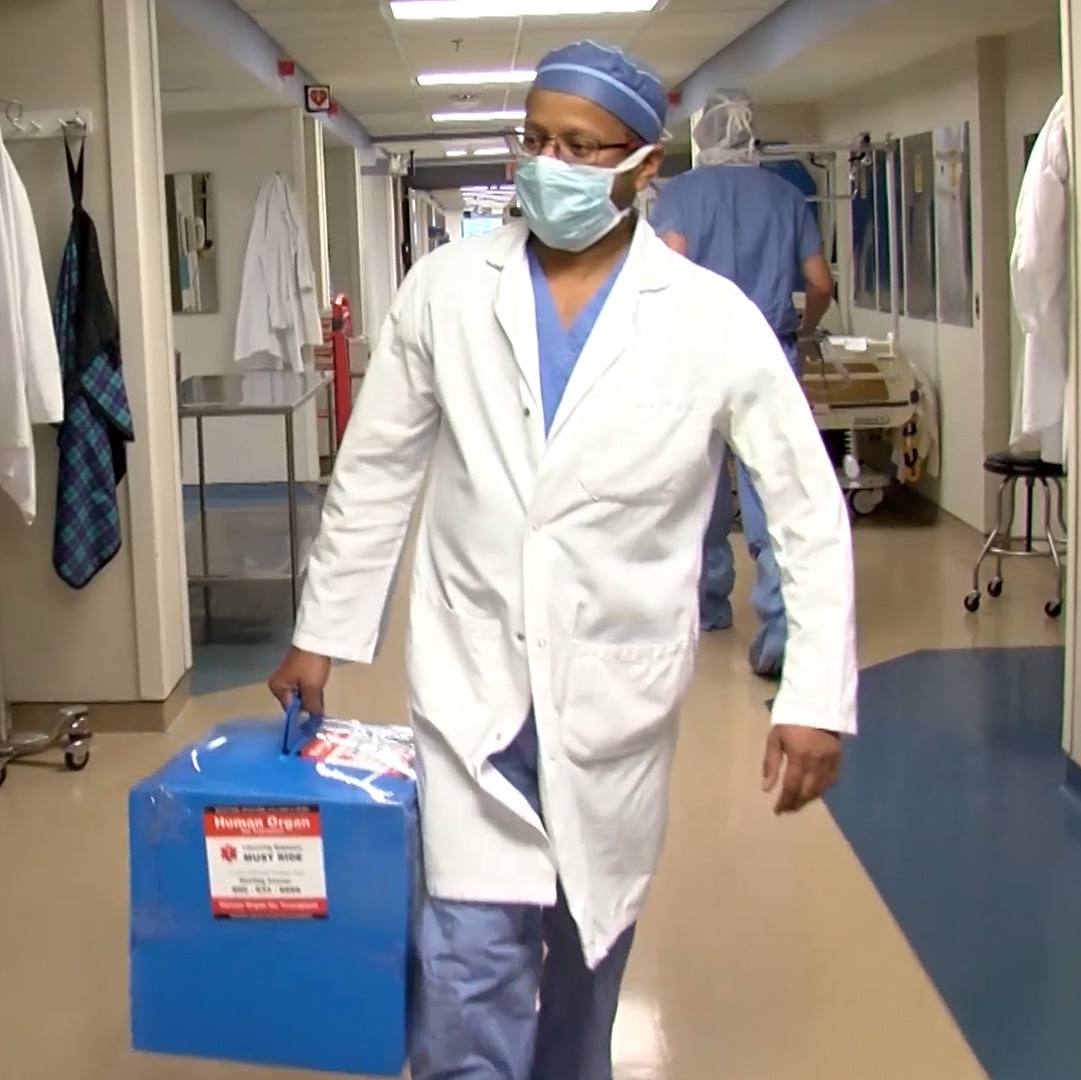-
Featured News
Sharing Mayo Clinic: A puzzling problem with a precision care solution

These days, Molly Hanson feels awesome. Free from pain, she's now eager to get back into her life. Molly's energy today stands in stark contrast to how she felt a year ago — before she visited Mayo Clinic and learned an undiagnosed medical condition was to blame for many of her debilitating symptoms.
Molly Hanson's life was spinning out of control. In near-constant pelvic and abdominal pain, she was chronically constipated, got lightheaded all the time, had irregular heartbeats and kept breaking out in a rash. For close to a decade, Molly ping-ponged between health care providers, searching for answers to her persistent medical issues. Despite many diagnoses — including slow bowel transit and postural tachycardia syndrome — and a multitude of treatments, nothing provided lasting relief.
"It's almost like I kept being dismissed, like what I had going on wasn't an issue," says Molly, who lives with her husband in Glenwood Springs, Colorado. "Deep down, I thought I was losing my mind."
Although Molly lost faith that she'd ever feel well, she continued searching for a path to improved health. One of those paths led her to a conversation with a co-worker, who asked Molly if she'd considered seeking care at Mayo Clinic.
"I never thought that going to Mayo Clinic they would find anything wrong because I was used to never getting answers, but I was so hopeful," Molly says.
That hope compelled Molly to request an appointment, and in November 2018, she flew to Mayo Clinic in Arizona. There she met the first member of a multidisciplinary care team who finally connected the dots between her many symptoms and was able to provide her with effective treatment.
"I have been through the wringer," Molly says. "From doctors looking at me and saying, 'I don't know what's wrong,' or 'We don't think there's anything wrong,' or 'We can't fix you,' to feeling like it's in my head, then going to Mayo and telling them my story and learning that everything I have is so rare, but hearing them say, 'We know what is wrong.' Mayo Clinic has saved my life and changed my life in so many ways."
A complicated history
When Molly arrived at Mayo Clinic, she'd been waging a 10-year war against her digestive system and slow bowel transit. Her condition resulted in constipation so severe she could go for weeks without having a bowel movement. Although Molly won a battle in June 2015 with the surgical removal of most of her colon and connection of her small intestine to the sigmoid colon, the fight continued when constipation returned.
Dizziness, lightheadedness and irregular heartbeats landed Molly the diagnosis of postural tachycardia syndrome, or POTS — a condition that affects the way the heart beats when shifting from sitting to standing. Molly received prescription medication to treat it. She also received prescriptions for anxiety and ulcers, as well as Hashimoto's disease — a condition in which the immune system affects thyroid function. And Hashimoto's wasn't the only autoimmune condition Molly developed. Her body broke out in a rash, and she was diagnosed with vasculitis, an inflammation of the blood vessels.
"I'm on thyroid pills and not getting better. I'm on anxiety medication. My bowels are not getting better. My rash keeps coming and going. What am I supposed to do?"
Molly Hanson
On top of all that, the pain associated with constipation was compounded by several bouts of severe pelvic pain and pressure that were so excruciating Molly required hospitalization. "I tried Dilaudid, morphine, all this stuff went into my IV, but nothing dulled my pain," Molly says. Eventually, the pain dissipated. It routinely returned, however, and Molly was hospitalized four more times.
Molly sought advice from her gynecologist, who suggested the pain could be due to the colon surgery causing her to develop a tight pelvic floor. "At this point, I'm frustrated. I was mad," Molly says. "I'm on thyroid pills and not getting better. I'm on anxiety medication. My bowels are not getting better. My rash keeps coming and going. What am I supposed to do?"
The answer to that question came not from a doctor, but from the work colleague who suggested Mayo Clinic. It was some of the best advice she'd ever received, Molly says. "I am doing so much better because Mayo did it so much differently."
A comprehensive approach
That difference was evident during Molly's first Mayo Clinic appointment in November 2018 with Paul Snyder Jr., M.D., in Consultative Medicine. "I've never had a doctor honestly sit down with me and really listen and dive in and make me feel like I'm not losing my mind," Molly says. "Paul Snyder looked into my eyes and said: 'This is not in your head. There is something wrong, and we're going to find it.' It was just such a relief."
Dr. Snyder referred Molly to Mayo specialists in the departments of Gastroenterology and Hepatology, Neurology and Rheumatology. They ordered a slate of tests focused on her most troublesome symptoms.
During her Neurology appointment, Molly underwent a tilt table test that confirmed her POTS diagnosis. She also was tested for mast cell disease, or systemic mastocytosis, an autoimmune condition that can cause symptoms such as itching, flushing, rapid heartbeat and lightheadedness. The results of that test came back positive. But that wasn't the only surprising finding Molly's Mayo team made during her initial two-week workup.
"I felt so relieved that finally someone found something."
Molly Hanson
A CT scan to look for an intestinal obstruction revealed something else: a pelvic venous outflow obstruction. The anatomical condition, known as May Thurner syndrome, occurs when the left common iliac vein gets compressed between the spine and the right common iliac artery. That inhibits the flow of blood as it travels through the pelvis to the heart. Among the many symptoms caused by May Thurner are pelvic pain, abdominal swelling and blood clots, as well as lethargy, depression, headaches and nausea.
"I felt so relieved that finally someone found something," Molly says. In March, Molly made an appointment with Grace Knuttinen, M.D., Ph.D., in the Interventional Radiology Clinic to undergo diagnostic testing and determine the severity of the blockage. It turned out that Molly's case was quite severe.
Molly also spent time in March with Mayo gastroenterologists to address her persistent constipation. As part of those appointments, Molly underwent tests to examine her remaining colon. After the testing, she met with surgeon Tonia Young-Fadok, M.D., in Colon and Rectal Surgery, who explained that during Molly's 2015 surgery, a portion of her colon was left behind, and it had become dysfunctional.
"She explained to me that she was going to take out the remaining sigmoid colon, which is the last bit of colon I had left, and basically attach the small intestine to the rectum," Molly says. "With it, we wouldn't have to worry about the slow transit."
Learning she required a second colon surgery was unnerving at first, Molly says. "I was like: 'Are you kidding me? We have to go through surgery again?' But I trusted her. I felt comfortable with her. She was amazing."
A lasting solution
Molly, who works as a middle school financial secretary, scheduled the colon surgery during her summer break. But Molly was back at Mayo long before then. Just one week after she returned home in March, she received a follow-up phone call from Dr. Knuttinen about the May Thurner syndrome. Dr. Knuttinen described the severity of Molly's obstruction at 97%, and she explained that the blocked venous blood flow may be contributing to Molly's chronic pelvic pain.
Molly returned to Mayo in April for a stenting procedure to relieve the venous obstruction. It involved inserting a catheter through her groin into her left common femoral vein. Using intravascular ultrasound, Molly's team then assessed the length and severity of the obstruction and determined the size of stent needed to open it and allow for normal blood flow from the pelvis to the heart.
Normally, the stent placement for May Thurner is an outpatient procedure, but Dr. Knuttinen wanted Molly to stay longer than that. "I admitted her because I was unsure how her improved blood return would impact her nervous system as it related to her POTS," Dr. Knuttinen says.
"I just started to feel calmer. I had more energy and just felt like I was starting to feel alive."
Molly Hanson
During Molly's hospitalization, Dr. Knuttinen visited her twice a day. "She is the most caring, sweet, probably my favorite doctor that I've ever had," Molly says. "I had quite a lot of back pain for about a month after the procedure. But instantly, I started feeling relief (from my other symptoms). My vision improved. The heaviness I felt in my abdominal area was getting better. I just started to feel calmer. I had more energy and just felt like I was starting to feel alive."
Two months after she received the stent, Molly returned to Mayo for her colon surgery, which was performed laparoscopically. "The colon surgery went really good. Everything healed up really well," Molly says. "So far I've noticed a difference where I have a bowel movement, and it doesn't hurt."
Life-changing care
Although Molly's Mayo Clinic journey is not over — she continues to work with her Mayo endocrinologist and neurologist to fine-tune the treatments for Hashimoto's and POTS and will be regularly monitored for neurological changes related to the disease — the change in her life since her surgeries has been profound.
"Who would've thought, 'Let's get you some proper blood flow and see what that makes you feel like?'" Molly says. "I'm finally getting my POTS under control. We're readjusting my thyroid medication, so that's becoming more under control. My energy is up, and every day I'm getting better. I can't tell you how long it's been since I've felt like this. I am so grateful I was given the opportunity to be seen by such amazing doctors and nurses at Mayo."
"These patients are very unique and need to be evaluated, diagnosed and treated very carefully."
Grace Knuttinen, M.D., Ph.D.
While Molly's journey has been long and complicated, she is not alone, Dr. Knuttinen says. "Pelvic venous insufficiency is underdiagnosed, misdiagnosed and undertreated. The impact that pelvic venous outflow lesions can have on various organ systems in the body is complex and challenging to understand."
As a result of treating patients like Molly and realizing the complexity of the diagnosis and management of these patients, Dr. Knuttinen formed a multidisciplinary chronic pelvic pain conference held monthly with her colleagues from Gastroenterology, Gynecology, Radiology and Urology. It also includes pelvic floor physical therapy specialists.
"These patients are very unique and need to be evaluated, diagnosed and treated very carefully. It's very complex how all of these things are related. But it's fascinating how the pathophysiology can all be linked together in some degree and offer insight to the whole puzzle," Dr. Knuttinen says. "I give Molly kudos for never stopping until she found answers."
HELPFUL LINKS:
- Read about chronic pelvic pain.
- Learn more about postural tachycardia syndrome.
- Check out the departments of Radiology and Gastroenterology and Hepatology.
- Connect with others talking about women's health on Mayo Clinic Connect.
- Explore Mayo Clinic.
- Request an appointment.







